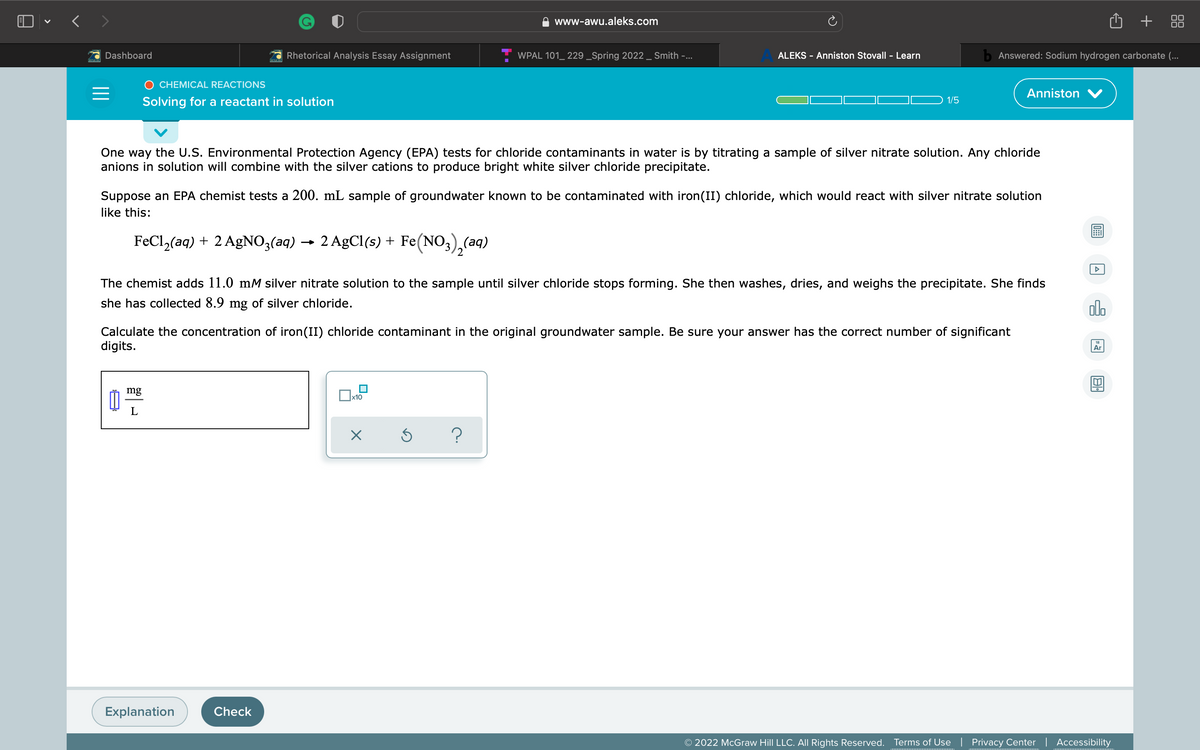One way the U.S. Environmental Protection Agency (EPA) tests for chloride contaminants in water is by titrating a sample of silver nitrate solution. Any chloride anions in solution will combine with the silver cations to produce bright white silver chloride precipitate. Suppose an EPA chemist tests a 200. mL sample of groundwater known to be contaminated with iron(II) chloride, which would react with silver nitrate solution like this: FeCl,(aq) + 2 AgNO;(aq) → 2 AgCl(s) + Fe(NO;),(aq) The chemist adds 11.0 mM silver nitrate solution to the sample until silver chloride stops forming. She then washes, dries, and weighs the precipitate. She finds she has collected 8.9 mg of silver chloride. dh Calculate the concentration of iron(II) chloride contaminant in the original groundwater sample. Be sure your answer has the correct number of significant digits. mg
One way the U.S. Environmental Protection Agency (EPA) tests for chloride contaminants in water is by titrating a sample of silver nitrate solution. Any chloride anions in solution will combine with the silver cations to produce bright white silver chloride precipitate. Suppose an EPA chemist tests a 200. mL sample of groundwater known to be contaminated with iron(II) chloride, which would react with silver nitrate solution like this: FeCl,(aq) + 2 AgNO;(aq) → 2 AgCl(s) + Fe(NO;),(aq) The chemist adds 11.0 mM silver nitrate solution to the sample until silver chloride stops forming. She then washes, dries, and weighs the precipitate. She finds she has collected 8.9 mg of silver chloride. dh Calculate the concentration of iron(II) chloride contaminant in the original groundwater sample. Be sure your answer has the correct number of significant digits. mg
Principles of Instrumental Analysis
7th Edition
ISBN:9781305577213
Author:Douglas A. Skoog, F. James Holler, Stanley R. Crouch
Publisher:Douglas A. Skoog, F. James Holler, Stanley R. Crouch
Chapter29: Supercritical Fluid Chromatography And Extraction
Section: Chapter Questions
Problem 29.11QAP
Related questions
Question

Transcribed Image Text:) - < >
O + 88
www-awu.aleks.com
Dashboard
Rhetorical Analysis Essay Assignment
WPAL 101_ 229 _Spring 2022 _ Smith -...
ALEKS - Anniston Stovall - Learn
Answered: Sodium hydrogen carbonate (..
O CHEMICAL REACTIONS
Anniston V
Solving for a reactant in solution
1/5
One way the U.S. Environmental Protection Agency (EPA) tests for chloride contaminants in water is by titrating a sample of silver nitrate solution. Any chloride
anions in solution will combine with the silver cations to produce bright white silver chloride precipitate.
Suppose an EPA chemist tests a 200. mL sample of groundwater known to be contaminated with iron(II) chloride, which would react with silver nitrate solution
like this:
FeCl,(aq) + 2 AgNO3(aq) → 2 AgCl(5) + Fe(NO3),(aq)
2
The chemist adds 11.0 mM silver nitrate solution to the sample until silver chloride stops forming. She then washes, dries, and weighs the precipitate. She finds
she has collected 8.9 mg of silver chloride.
ol.
Calculate the concentration of iron(II) chloride contaminant in the original groundwater sample. Be sure your answer has the correct number of significant
digits.
Ar
mg
x10
L
Explanation
Check
© 2022 McGraw Hill LLC. All Rights Reserved.
Terms of Use | Privacy Center | Accessibility
Expert Solution
This question has been solved!
Explore an expertly crafted, step-by-step solution for a thorough understanding of key concepts.
This is a popular solution!
Trending now
This is a popular solution!
Step by step
Solved in 2 steps with 1 images

Knowledge Booster
Learn more about
Need a deep-dive on the concept behind this application? Look no further. Learn more about this topic, chemistry and related others by exploring similar questions and additional content below.Recommended textbooks for you

Principles of Instrumental Analysis
Chemistry
ISBN:
9781305577213
Author:
Douglas A. Skoog, F. James Holler, Stanley R. Crouch
Publisher:
Cengage Learning

Physical Chemistry
Chemistry
ISBN:
9781133958437
Author:
Ball, David W. (david Warren), BAER, Tomas
Publisher:
Wadsworth Cengage Learning,

Principles of Instrumental Analysis
Chemistry
ISBN:
9781305577213
Author:
Douglas A. Skoog, F. James Holler, Stanley R. Crouch
Publisher:
Cengage Learning

Physical Chemistry
Chemistry
ISBN:
9781133958437
Author:
Ball, David W. (david Warren), BAER, Tomas
Publisher:
Wadsworth Cengage Learning,